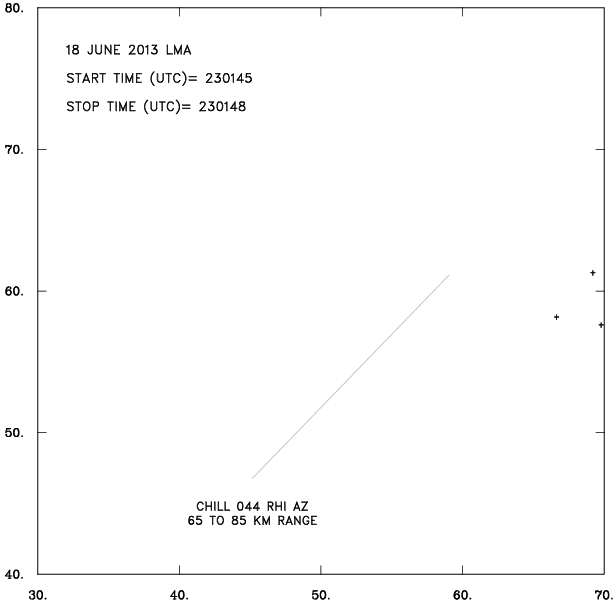DPWX/Thunderstorm electrification signature: 18 June 2013
Author: Patrick C. Kennedy
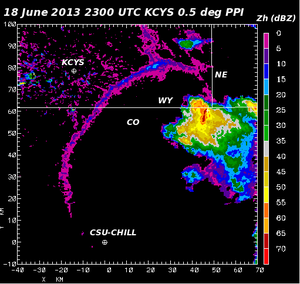
NWS Cheyenne WY (KCYS) low elevation angle reflectivity data depicts a strong thunderstorm near the intersection point of Nebraska, Wyoming, and Colorado. The leading edge of the surface outflow from this mature storm was also detected to the southeast of KCYS. Differential propagation phase data collected by the CSU-CHILL radar indicated that strong electric fields were present at upper levels of the storm. Lightning activity near this strong field signature was confirmed by data from the northern Colorado Lightning Mapping Array (LMA).
Overview
Thunderstorms, some of which were severe, developed in several portions of the CSU-CHILL radar's coverage area during the afternoon hours of 18 June 2013. Around 2300 UTC, a number of RHI scans were conducted through a storm that was located near the triple point formed where the state boundaries of Colorado, Nebraska and Wyoming meet (located approximately 65 km north-northeast of CHILL). The following plot shows the CSU-CHILL S-band reflectivity data obtained in a low elevation PPI scan just before the RHI scanning was started. The corresponding Zdr data (not shown), indicated that hail was present in much of the high reflectivity core. The red line segment shows the location of a selected portion of the 044 degree azimuth RHI plane.
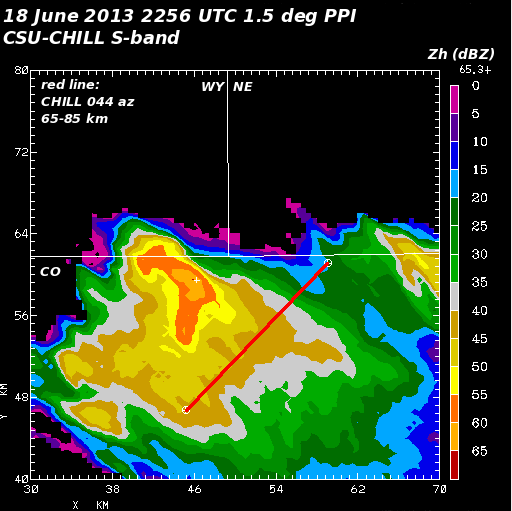
044 deg RHI scan data
The next plot shows the the S-band reflectivity data collected in an RHI scan on an azimuth of 044 degrees at ~2302 UTC. As shown by the red line in the preceding PPI plot, this RHI was located ~10 to 15 km to the southeast (rear) of the reflectivity core.
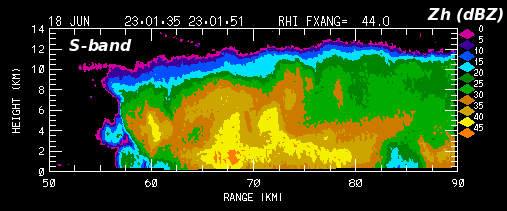
The S-band differential propagation phase data from the same RHI sweep is presented in the next plot. At near-surface levels, where the propagation path includes an appreciable component of oblate raindrops, the color progression with increasing range is in a downward direction along the color bar (i.e., dull yellow to bright yellow). In the upper portion of the echo, between heights of ~8 - 10 km AGL, the color progression with range is in the opposite (upscale, dull yellow to green) direction; indicating that asymmetric ice particles have their major axes oriented towards the vertical. Prior research has shown that sufficiently strong electric fields can rotate ice crystals from their aerodynamically stable horizontal orientation towards a direction that aligns with the local electric field lines (Caylor and Chandrasekar; 1996 IEEE Transactions on Geoscience and Remote Sensing, p. 847-858).
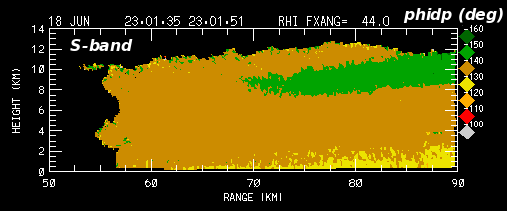
The next plot shows the corresponding X-band phidp data; the color scale is the same as was used in the S-band phase data plot. Since phidp sensitivity is inversely proportional to wavelength, the magnitude of the color scale excursions at X-band are amplified relative to those seen at S-band. The X-band phase pattern also suggests that the ice crystal orientation becomes more horizontal in narrow layers located just above and below the main negative phase shift altitude band. This implies that the overall charge structure produced curved electric field lines that locally favored both horizontal as well as vertical ice crystal orientations (Hubbert et al., 2014 JAMC p. 1659 - 1677.)
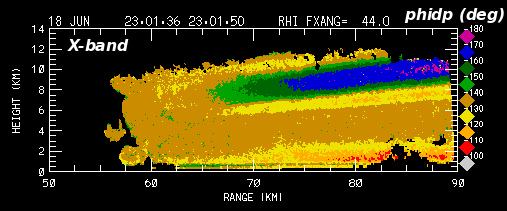
KFTG - KCYS dual-Doppler wind synthesis
A dual-Doppler wind field synthesis was done to characterize the horizontal flow in the vicinity of the strong electric field signatures seen in the phidp data. Since the CSU-CHILL radar was not conducting volumetric scanning, the dual-Doppler synthesis was done using data from the Denver (KFTG) and Cheyenne (KCYS) WSR-88D radars. The starting times of the two input volume scans were well synchronized (2300:11 UTC for KFTG and 2300:06 UTC for KCYS), but the very long baseline separating the radars (~154 km) resulted in coarse spatial resolution. In the following plot, the input data was interpolated to a Cartesian grid with a 2 km horizontal mesh size. A storm motion from 200 degrees at 13 mps was subtracted from the basic dual Doppler wind field. The resultant storm-relative flow field at the 9.5 km MSL height level is shown below. The CSU-CHILL RHI plane was positioned across the enhanced flow that was streaming around the northeastern and southwestern flanks of the reflectivity core. Charge separation likely occurred due to particle collisions in the updraft associated with the echo core. It is speculated that the two locally-accelerated flow branches that flanked the reflectivity core advected charged ice particles into the downstream echo region that was sampled by the RHI scan. The accumulation of these charged particles produced regions where the electric field became strong enough to cause the local reorientation of ice crystals.
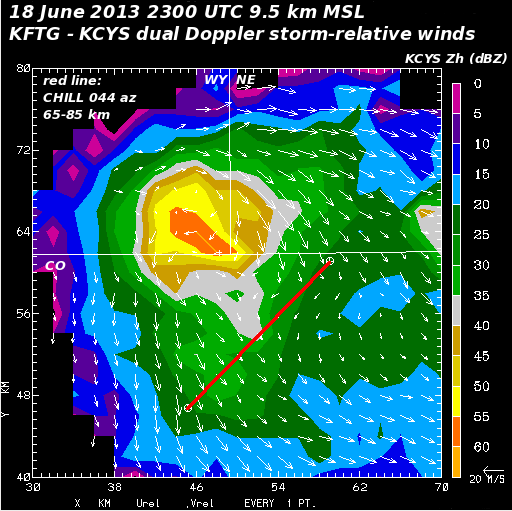
LMA data
The development and propagation of lightning discharges is intimately related to the presence of strong electric fields. Data from the Northern Colorado Lightning Mapping Array (LMA) network was examined to monitor the evolution of lightning activity in the vicinity of the electrification signatures seen in the CSU-CHILL 044 degree azimuth RHI scan. The LMA network receives the VHF emissions that are generated by the charge propagations (i.e., stepped leaders, etc.) that occur during lightning discharges. By measuring the arrival times of the VHF signal bursts at a network of ground stations, the LMA system can map the three dimensional evolution of lightning activity. In the final image loop, the horizontal locations (at any altitude) of LMA-detected lightning discharge activity are plotted in three second long time blocks starting at 2103:45 UTC. (This was the data collection time for the rays in the 044 degree RHI scan that intercepted the strong electric field signature). The LMA data shows that fairly extensive discharge activity occurred near the RHI plane a few seconds later (2301:51 - 2301:54 UTC). The average height of the detected discharges during this three second period was 8 km MSL. The occurrence of this lightning was probably related to the existence of the strong electric field levels that were implied by the differential propagation signatures seen in the upper portions of the CSU-CHILL RHI scan.
|
|
||
|
